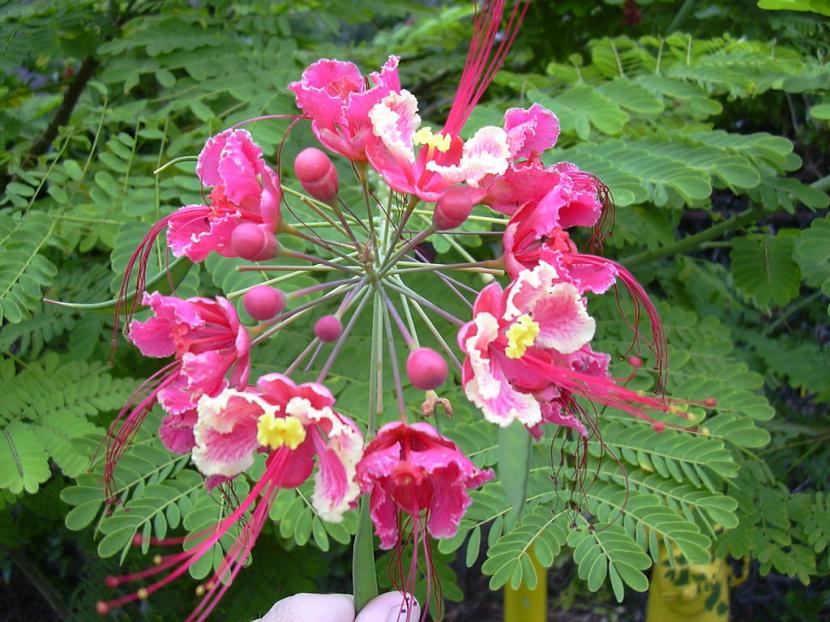
If you have ever seen the flamboyant tree, whose scientific name is Delonix directionIt is very easy to confuse it with the plant that I am going to tell you about next. In fact, its popular name is »false flamboyant»: Such is their similarity! But it has interesting differences, especially in terms of rusticity.
Meet the Caesalpinia pulcherrima, a kind of singular beauty.

This beautiful large shrub or small tree, depending on the size you prefer it to be, is native to tropical America. Specifically, in the Dominican Republic it is a very, very common plant, where it is used to decorate both private and botanical gardens, urban walks, parks ... anyway. Its dimensions and its easy cultivation make it a ideal species to plant anywhere.
Its main characteristics are as follows: it grows to a height of three meters, and has light green bipinnate leaves. Its beautiful flowers appear in clusters, with 5 petals each that can be yellow, orange, pink or red. It is, as we see, ideal for small gardens, and also for potting.

As we have said, it is very similar to Delonix direction, but the truth is that C. pulcherrima It is not as sensitive to cold as that, so much so that it can withstand light and short-term frosts once established, unlike the flamboyan, which needs a climate that remains warm throughout the year. But also, if the temperatures in our area are below -2ºC, we can have our Caesalpinia at home during those months in a very bright room.
If we talk about irrigation, this it will have to be frequent. The black peat mixed with perlite (in a ratio of 7: 3), has to be kept slightly humid, especially during the summer. In autumn and winter we will decrease the frequency of watering, to allow the soil to dry out.
What did you think of the false flamboyan? 😉
Hello, good morning, Monica, I am writing to you from the beautiful coffee lands of Colombia, more exactly from the city of Pereira, I wrote to you a while ago about what you recommended to plant in my garden since I wanted a medium tree that does not have large roots, how good shade and flowers in the most beautiful way possible, in my city we have a minimum temperature of 15 degrees C and a maximum of 32 degrees C throughout the year without seasons, you recommended some I saw them and the truth was I did not like some neighbors very much They have them and I do not see them as I wish them these were the Tabebuia or the Cassia fistula you told me that the flamboyan discarded it because of its inasive roots and I met this shrub that you are talking about in this blog which is something similar but I do not like its form of shrub This shrub can be raised from a young age to take the shape of a strong, single-stemmed tree like the Flamoyan? let me stay like this https://images-na.ssl-images-amazon.com/images/I/91YeEDiagZL._SL1500_.jpg
I was also looking at the Crespon or Jupiter but this one is also in the shape of a bush I knew that it can be educated and made to grow with a single strong stem but the few that I have seen so far are not very graceful and have very long branches in the form of rods. and little flowering how do I look like this https://images-na.ssl-images-amazon.com/images/I/91YeEDiagZL._SL1500_.jpg
I will continue in the search for the right tree and that it impacts me, I hope not to bother you again with my whims, a thousand thanks, greetings from Colombia
Hello Juan Alberto.
These two plants can be pruned to give them the shape of a tree. You simply have to leave the trunk free of branches, and cut the branches so that new shoots come out, making the crown more compact.
Anyway, if you decide to do with them, you can send me photos through our Facebook profile and I'm telling you.
A greeting.